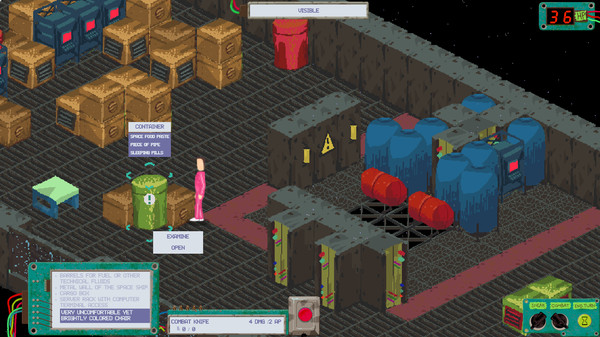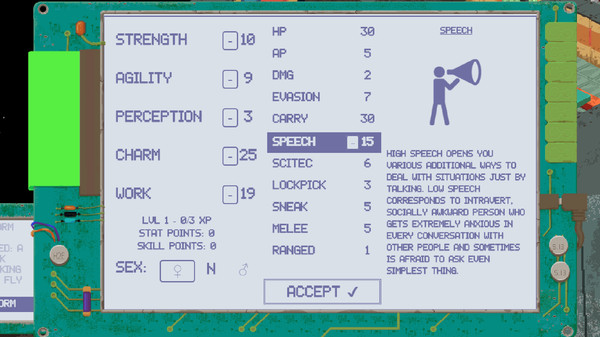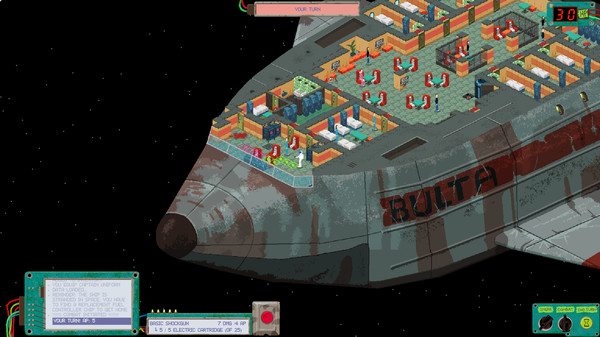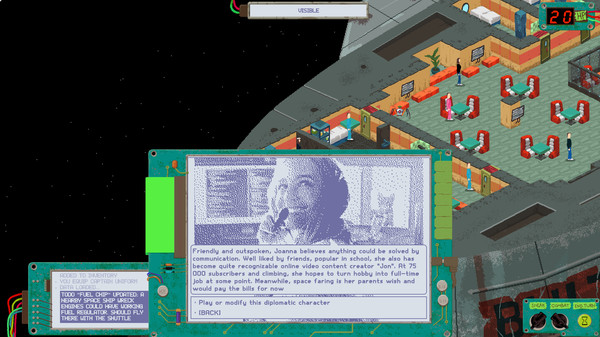EM: In terms of style, the pixel art translates to a Commodore 64 feel; in implementing and creating a unique look, what drives your visual aesthetic?
MC: For some reason, dilapidated industrial complexes, naked electronics, and boxy designs resonate with me. It might be the exposure to Fallout games at an early age, but probably more so the fact that I was growing up in the aftermath of the U.S.S.R collapse. I’ve spent my fair share of time exploring abandoned military bases (even rocket silos), decaying factories, vacated towns, and the eerie dunes of tank training grounds (that look like sands of the wasteland a bit). It all rubbed off on me a bit, I gather, including boxy 80s electronics, naked wires, open circuits, and other staff that was usually lying around there.
And I believe our artist, Ernest Klavins, has created a convincing interpretation of this concept. I especially like the enormous set-pieces, like that space tanker.
Oh, and the oversaturated colors – it is an inspiration from space photos which usually have very high contrast because there is no air to disperse and soften the light.
EM: You’ve created an earlier version of the game and talked about intentional brevity; as the titles you mention as inspiration are notable for their huge, open world experiences, do you see the scope of your work expanding as you go, or are you simply creating a small universe with many possible paths?
MC: “Inch wide, miles deep” – that has been the motto of my development from the get-go. When expanding the game, instead of prolonging it linearly, I would prefer to take an existing area, a quest or NPC, and just add more options, more ways to play through/around it; dig it deeper if I can. Less side-quests, more side options.
Having said that, the original concept of Space Wreck had you travel around the Junkspace – the area between mining stations with destroyed or abandoned industrial ships where survivors have taken refuge after the devastating clashes tens of years ago. There they built their societies, “towns”, each with its distinction and story. A player could get the needed McGuffin in various ways, via multiple locations, so it would not be mandatory to visit all of them. This would create different stories for each playthrough based on the wreck you’ve decided to visit.
In the current version of the game, however, I decided to focus only on one such wreck. The rest of the world – the Junkspace – still exists around the player, seen in the story, context, and smaller details.
EM: I note you’re using Meta 2D as an engine (at least in the earlier version), so from a design standpoint, can you describe that choice? What does your development environment look like, and what tools do you find essential?
MC: When the game development startup I was working at ran out of runway, and I had to find another job; I realized I need some JavaScript training. And the best way – I thought – was to create a game. To avoid writing all the basic stuff from scratch – tiling, animation management, resources loading, pathfinding etc., I opted for an existing engine, the Meta2D, which was being developed by a member of our local game dev community I hung out with. It probably should have been safer to choose a more prominent and popular framework, but now the project has grown too big to change the engine and yeah, it’s still there with all of its little quirks.
As per tools – I use Visual Studio Code as an editor for JavaScript and Elm; the maps visually are laid out with Tiled. Art is created in Aseprite, and I use Spine for character animations.
The content, however, is being developed within the game itself in a special development mode. It works like this – you play the game, then, when you need to add or change something, just enable dev mode and edit, for example, NPC dialogue on the fly, or adding an item to a container, or placing a new NPC. Save it and voila – it’s in the game. Development mode also contains various shortcuts to quickly get to you to any point of the story or have a character with any stats/items you need.
Probably one of the bigger challenges was the dialogue editor, since I have to handle so many conditions and navigate through an entangled tree of choices. I’ve been fighting to get this right in my previous games, but it seems this version is the most comfortable and powerful to date.
EM: Tactical turn-based combat has evolved since the ’90s with varied results, sometimes moving toward faster play, sometimes focusing on a wider variety of tactical choices. When it comes to the actual mechanics (stats, hit percentages, movement), where do you see Space Wreck adding to the genre, and what elements feel like standard fare?
MC: I’m not sure if it is obvious enough, but the game is quite minimalistic, and this is by design. I wanted to explore the “minimal viable RPG” concept with a small number of attributes and stats that still allow for diverse roleplaying. Consequentially, combat also is a pretty minimalistic interpretation of classic turn-based warfare: you’ve got your action points to move and shoot, basic hit points, DT armor. In fact, there are only two attack skills – melee and ranged.
On the other hand, I’m toying around with fun additions, like zero-G long jumps – since the gravity is effectuated via magnetic soles, thusly enabling your character to detach from metallic floors and fly across the room. Or maybe kick your opponent off the ground instead. These are the kind of things I want to hone in the early access period with the help of the community.
EM: In terms of implementation, there are always a few things that stand out as novel, creating an – oh, I’ve never seen that before – feeling. Over the last weeks and months, what would you hold up as your moments of triumph? Where do you see yourself blowing minds?
MC: One time I posted a funny gif in a chat of NPCs reacting to you being naked (like in Arcanum), and there arose an idea that people would try to not look at the naked protagonist, allowing you, for example, to steal stuff unnoticed. I implemented NPCs turning the other way and, indeed, in some cases, it did provide you the edge of getting away with picking a lock.
But on a more serious note – it was a showcase of one additional dialogue feature that got a surprisingly good reaction: with high enough perception, you can get the psychological profile of the NPC, the kind police would create of a suspect. This allows you to know the context for her/his behavior and also predict possible reactions to your decisions. Additionally, sometimes, that would unlock extra dialogue options.
This is something not uncommon in tabletop roleplaying sessions with human GMs, but I haven’t seen that in many computer RPGs.












![The Year of Incline [2014] Codex 2014](/forums/smiles/campaign_tags/campaign_incline2014.png)



























